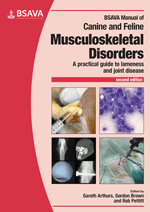
Full text loading...

Detailed knowledge of the normal anatomy and physiology of healthy canine and feline joints is essential to help recognise abnormalities presented by patients. This chapter describes common anatomical features of joints, joint innervation, cartilage, meniscus, synovium and synovial fluid, subchondral bone, ligaments and tendons.
The normal joint, Page 1 of 1
< Previous page | Next page > /docserver/preview/fulltext/10.22233/9781910443286/9781910443286.5-1.gif

Full text loading...











